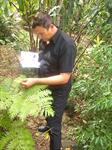
Why Are Environmental Assessments Necessary?
Sometimes an assessment is mandatory; required by law. Other times, it is the best route to take to develop a thorough understanding of the status of a place, ecosystem or environmental asset.
Undertaking an assessment prior to development or purchase of a property can be a wise decision; often an insightful indicator of whether the purchase or development should proceed.
Sometimes an assessment is undertaken to gather information which may be used as a basis for planning future development.
Other assessments are carried out for routine monitoring of the status of a particular area of land. It may be focussed on monitoring changes in the population of a particular plant or animal species; or perhaps to gauge any change in the geology (e.g., water erosion, volcanic or earthquake activity, air pollutants, etc).
COURSE STRUCTURE AND CONTENT
There are 8 lessons in this course:
1. Types of Employment for Environmental Scientists
- Pre-purchase inspections
- Background data
- Flora and Fauna Surveys
- Open Space Management Plans
- Detection of Pollutants
- Use of Plants
- Remediation of Polluted Sites
2. Introduction to Environmental Assessment
- What is Environmental Assessment?
- Definitions of Environmental Assessment
- General Principles and Overview of Environmental Assessment
3. International Environmental Law
- Foundations of Environmental Law
- Making International Laws (Treaties and Customary Law)
- Milestones in International Environmental Law
- Principles of International Environmental Law
- Institutions that influence Environmental Law
- Environmental Impact Assessment and Environmental Law
4. Domestic Environmental Law
- Examples of Domestic Environmental Law
- Research into Domestic Environmental law
5. Types of Environmental Assessments
- Environmental Impact Assessment
- Environmental Impact Statement
- Risk Assessment/Risk Analysis
6. The Design and Process of Environmental Assessment
- Steps in the Environmental Assessment Process
- Scoping, Screening, Alternatives to the Proposal, Collection and Analysis of Information, Public Involvement, Reporting the Findings of the Study, Post Project Analysis
- Baseline Studies, Predicting Impacts, Mitigation Measures
- Data Collection and Analysis
7. Writing Environmental Reports
- The Scientific Method and Report Writing
- Generic Outline for an Environmental Statement
- Examples of Suggested Layouts for Environmental Assessments
- Effective Report Writing.
8. Research Project
The Research Project is the student’s opportunity to test out their skills as an environmental consultant. In this project, the student will carry out a small environmental assessment and write it up as a professional report.
AIMS
- Develop an understanding of the basics of environmental study design, analysis and reporting within a legal framework.
- Be aware of the international legislation relevant to environmental assessment
- Research the legislation which dictates the environmental assessment requirements in the student’s home country.
- Appreciate the range of environmental assessment techniques that have been developed to assess a range of situations around the globe.
- Understand the environmental assessment process in enough depth to man
age a small environmental assessment.
- Write a professional environmental report.
- Prepare an environmental impact assessment including carrying out all research and writing up the actual report.
Different Types of Environmental Assessors
Environmental Assessors are often specialists. Some may specialise in sampling and testing soil or rocks, while others may be experts in assessing populations of flora or fauna.
Soil samples could then be taken where the oil stains were observed and an analysis requested for “oil and grease”, and “aromatic hydrocarbons”. It is important for scientists to be specific when requesting laboratory tests rather than just requesting a test of “samples for pollution”. Laboratories will ask which tests (of the approximately 45,000 tests available) are needed, and how many tests can they invoice for? Some laboratories will be registered to carry out tests x, y and z, but not a, b and c. Therefore, scientists may need to seek testing from more than one laboratory.
Noise levels may need to be assessed for or by some regulatory authorities (such as the Environment Agency in the UK, or the Environmental Protection Agency in Australia) to have as a condition of an environmental license that the company needs to contain the noise levels to “background noise level plus 5dB(A)” or something similar. So, the scientist will need to know what the background level is for each specified bracket of time during the day (e.g., 7am to 10pm; 10pm to 7am) for each specific day (e.g. Monday to Friday, Saturday, Sunday and public holidays). The investigation would also identify the closest affected receiving area. For example, a school would be seen to be a very sensitive receiving area whereas a factory would be seen to be a rather insensitive receiving area.
Air Quality often needs to be assessed prior to a development approval, or on an ongoing basis in urban or industrial areas. The air quality must be measured to provide baseline data on air quality as a gauge for comparison. Air quality is generally measured based on the presence of contaminants or pollutants which may be harmful to humans, animals or plants on or near the site. Air quality assessments are used to assess baseline levels of current emissions and meteorological conditions. They can then be used to predict the potential changes to air quality as a result of a potential development.
 Fauna and Flora often needs monitoring and assessing prior to a developer making changes to a site. In such cases, they will need to have an environmental consultant conduct a survey of the site to determine what flora (plants) and fauna (animals) are present. In particular, the consultant may look for ecologically significant features such as rare or endangered species, or habitat features such as hollow logs used by fauna. The consultant may advise of ways to reduce the impacts of a development on a site, and they may make suggestions for rehabilitation. For example, if a shopping centre is proposed for a certain site, the environmental consultant may recommend that only certain trees may be cut down, and that a certain number of trees be replanted in the area to replace these. The consultant may also recommend that wildlife be captured and moved to another location.
Fauna and Flora often needs monitoring and assessing prior to a developer making changes to a site. In such cases, they will need to have an environmental consultant conduct a survey of the site to determine what flora (plants) and fauna (animals) are present. In particular, the consultant may look for ecologically significant features such as rare or endangered species, or habitat features such as hollow logs used by fauna. The consultant may advise of ways to reduce the impacts of a development on a site, and they may make suggestions for rehabilitation. For example, if a shopping centre is proposed for a certain site, the environmental consultant may recommend that only certain trees may be cut down, and that a certain number of trees be replanted in the area to replace these. The consultant may also recommend that wildlife be captured and moved to another location.
Why Study with ACS?
Design your own learning pathway.
Study at your own pace, from anywhere, at any time.
Receive prompt, expert support from our team of committed and friendly tutors.
Your learning is our priority. We are flexible and adaptable to meet your educational needs!
Enrolling is easy - just go to the top of this page and select your study method and payment option.
If you have any questions about studying with ACS, or want to know more about any of our courses, get in touch with our specialist tutors today. They will be happy to answer your questions and look at different study options to fit in with your goals.